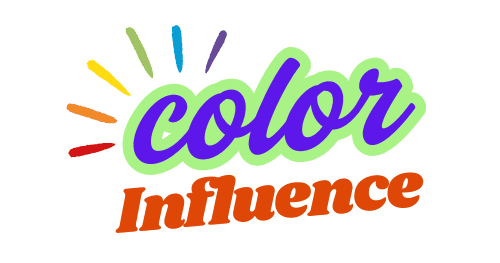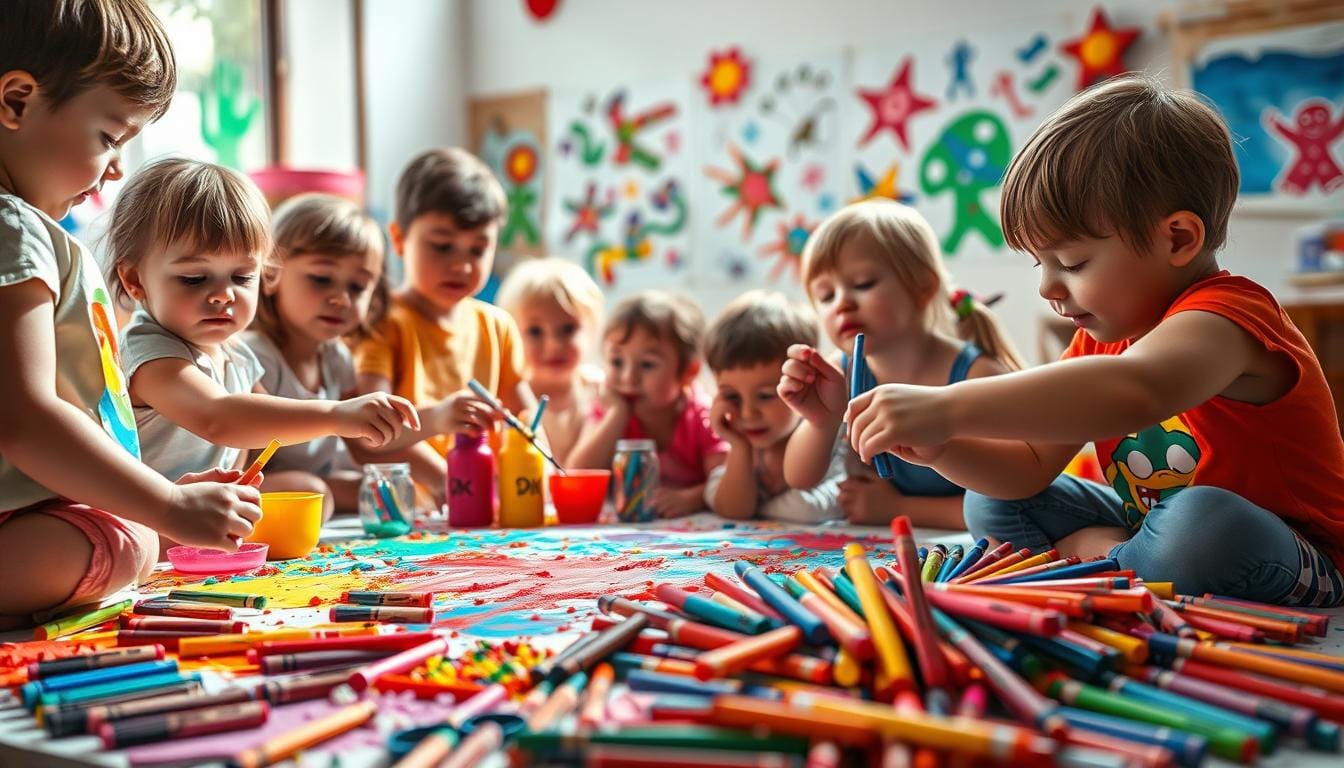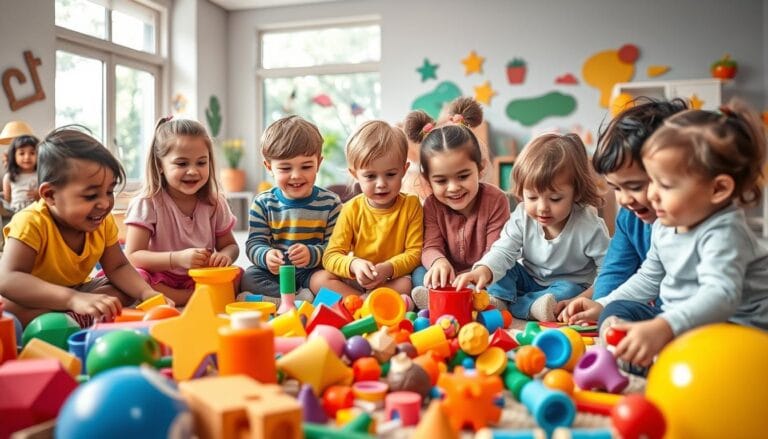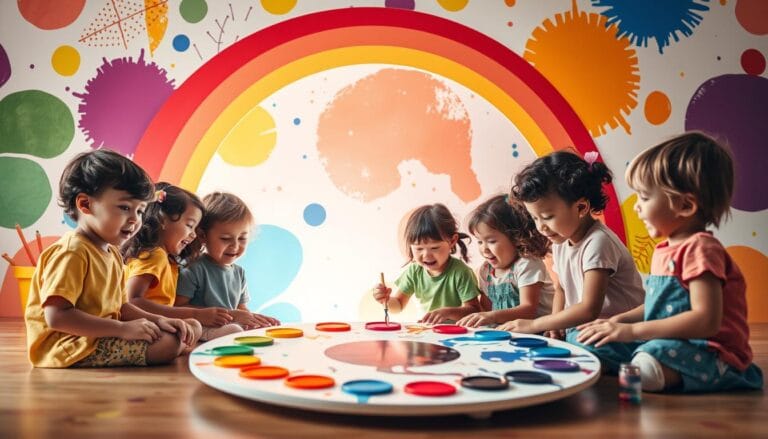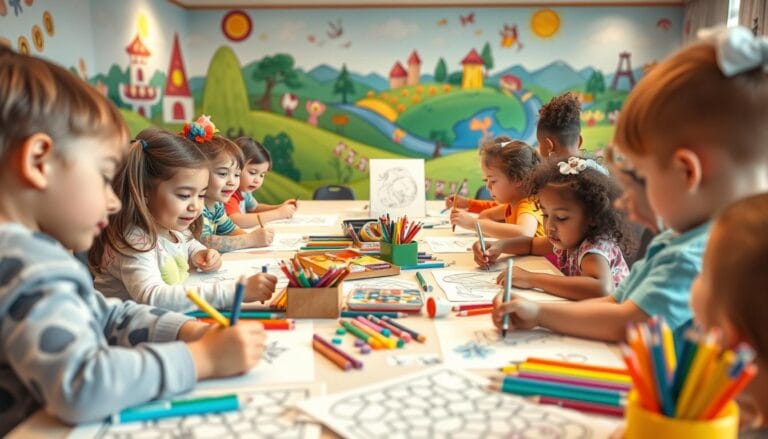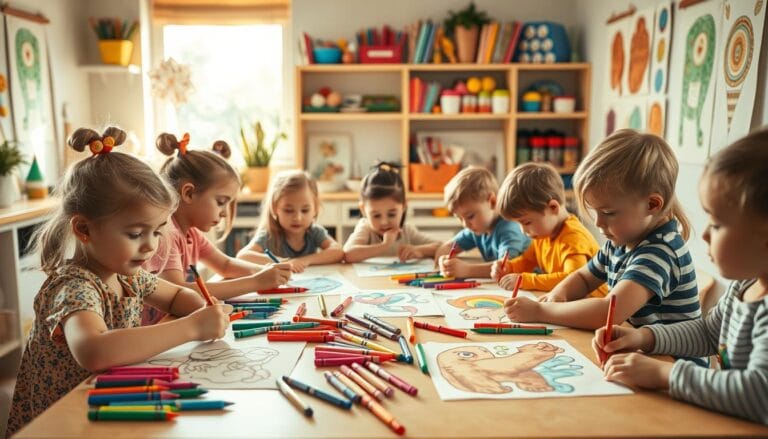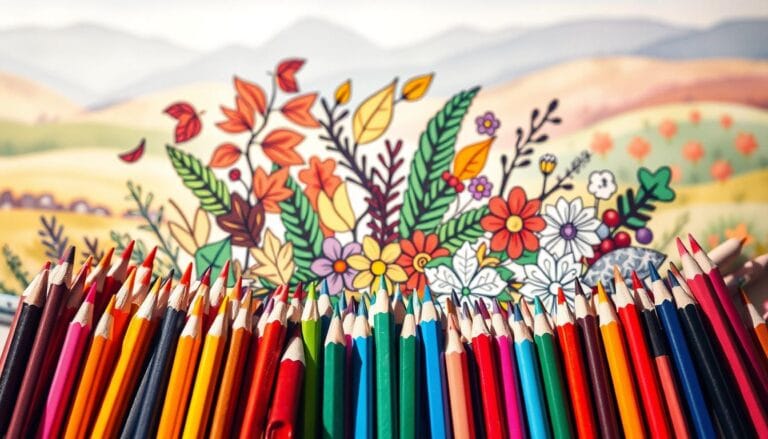The Magic of Colors: Fun Ways to Spark Creativity in Kids
Imagine a world full of bright colors that catch your child’s eye. Colors are more than just pretty sights. They open doors to imagination, learning, and feelings. Every time your child draws or paints, they tell a story that’s full of meaning.
Color psychology shows that colors affect us deeply. They can change how kids see and feel about the world. Colors like blue calm us, while red makes us feel alive. Each color has its own special message for kids.
Starting your child’s creative journey is easy. It’s all about exploring colors and what they mean. Through fun activities, they learn to express feelings and discover new things. Whether it’s mixing paints or sorting blocks, every moment is a chance to learn and grow.
Understanding Color Psychology in Child Development
Colors are more than just what we see. They shape emotions, learning, and how we think. Color psychology is key in how kids see and interact with their world.
Studies show how colors affect young minds. Kids’ brains soak up color in a special way. Each color makes them feel and think differently.
The Impact of Colors on Emotions
Colors and feelings are closely linked in kids’ minds. Here’s how different colors make them feel:
- Red: It’s all about excitement and energy
- Blue: It brings calmness and stability
- Yellow: It sparks happiness and creativity
- Green: It’s all about balance and growth
How Colors Influence Learning
Colors are great for learning. They help kids focus, spark creativity, and process information better. Bright colors grab the attention of little ones more easily.
Color Perception Development Stages
How kids see colors changes a lot as they grow:
- Infants start to tell colors apart at 2-4 months
- By 3, kids know and like certain colors
- Preschoolers link colors with feelings and things
- School kids understand more complex color meanings
Knowing about color psychology helps parents and teachers. They can make places that help kids grow emotionally and intellectually.
The Magic of Colors: Exploring Primary and Secondary Colors
Dive into the fascinating world of color theory and discover the magic of colors that transform art and learning. Young artists will be amazed by how just three primary colors can create an entire spectrum of visual excitement!
Primary colors are the superheroes of the color world. These three magical colors – red, blue, and yellow – are the foundation of all other colors. They cannot be created by mixing other colors, making them truly special in the realm of color theory.
When you mix these primary colors, something extraordinary happens. Let’s explore the exciting world of secondary colors:
- Red + Blue = Purple
- Blue + Yellow = Green
- Red + Yellow = Orange
“Colors are the children’s first language of creativity!” – Art Educator
Each color brings its own emotional magic to the palette. Red bursts with excitement, blue whispers calm, and yellow radiates happiness. The magic of colors goes beyond simple mixing – it’s about understanding how colors make us feel and think.
| Color Type | Colors | Emotional Association |
|---|---|---|
| Primary Colors | Red, Blue, Yellow | Foundational, Energetic |
| Secondary Colors | Purple, Green, Orange | Playful, Complex |
Your color journey is just beginning! Experiment, mix, and watch the magic unfold as you explore the wonderful world of colors.
Interactive Color Learning Through Story Books
Storybooks are magical portals that turn color learning into an exciting adventure for kids. Interactive books create immersive experiences that engage multiple senses. They spark curiosity about colors and storytelling. Research shows that 75% of children show more interest in books with interactive elements.
These special books do more than just teach color meanings. They weave color symbolism into narratives that captivate young minds. They encourage active participation. An impressive 80% of educators say interactive books make classroom story time better and promote family engagement.
Popular Color-Teaching Books for Different Ages
Some standout color-themed books capture children’s imagination across various age groups:
- The Day the Crayons Quit – Playful narrative exploring color personalities
- Pete the Cat: I Love My White Shoes – Engaging story about color transformations
- Mix It Up! – Interactive book teaching color mixing
- Brown Bear, Brown Bear What Do You See? – Classic color recognition story
Creating Story-Based Color Activities
Transform reading time into an interactive color exploration. Encourage your child to:
- Act out color scenes from the book
- Draw characters in different colors
- Create sound effects for color changes
- Match book colors with objects around the room
Reading and Color Recognition Games
Turn storytime into a playful learning experience. Play simple games like color scavenger hunts or matching characters to color cards. These activities help children develop color recognition skills while making reading fun and memorable.
Hands-On Color Mixing Experiments
Explore the world of color theory with fun experiments. These activities turn learning into a magical journey. Kids can see how colors mix and make new shades.
Color design becomes fun with these experiments. Young learners will see the magic of mixing colors. They’ll enjoy simple yet fascinating activities that make color theory come alive.
- Color Mixing with Water & Eyedroppers: Create secondary colors by blending primary colors
- Magic Milk Color Explosion: Watch colors dance and swirl with a simple chemical reaction
- Rainbow Sensory Bottles: Observe color mixing in a safe, contained environment
- Color Mixing in a Bag: Explore color combinations without making a mess
Primary colors (red, yellow, blue) are the base for all color adventures. By mixing these, kids can make exciting new shades:
- Red + Blue = Purple
- Red + Yellow = Orange
- Blue + Yellow = Green
These experiments teach color theory and improve fine motor skills. Your child will be amazed at how simple things can create a world of color!
Art Projects That Teach Color Recognition
Learning colors is fun for kids. Art projects make it magical. They help kids understand color therapy and current trends. These activities make learning colorful and exciting.
Studies show art projects boost kids’ learning. Kids in art projects see big improvements. They get better at:
- 30% improvement in fine motor skills
- 85% better color recognition
- 40% increased emotional expression through colors
- 50% enhanced sensory awareness
Painting Activities for Different Age Groups
Art projects fit different ages. Toddlers explore with their senses. Early elementary kids learn creative techniques. Preschoolers do well with primary colors like yellow, red, and blue.
Collage Making with Color Themes
Collage making is a special way to learn colors. Kids cut, arrange, and mix colors. They improve spatial skills and creativity. It lets them try out color trends and express themselves.
Color-Based Sensory Play Ideas
Sensory play makes learning colors fun. Try these ideas:
- Texture-based color exploration
- Mixing paint with different materials
- Creating 3D color sculptures
- Exploring color gradients through touch
| Age Group | Art Activity | Skill Development |
|---|---|---|
| Toddlers | Finger Painting | Sensory Awareness |
| Preschool | Color Mixing | Color Recognition |
| Early Elementary | Collage Making | Creative Expression |
Art projects teach color recognition. They help kids love creativity and colors. Every brushstroke and collage is a chance to learn. It makes education fun and colorful.
Color Games and Physical Activities
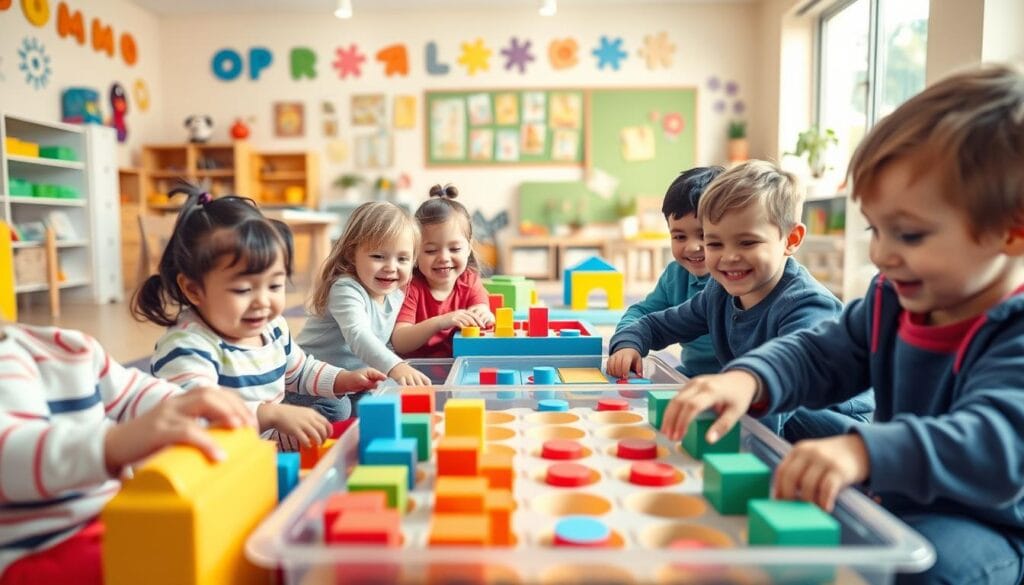
Color learning can be super fun through exciting physical activities. These games spark kids’ curiosity and help them learn. They mix movement, color recognition, and understanding emotions.
Here are some fun color-based games that boost creativity and learning:
- UNO Color Sorting Challenge: Remove number cards from a UNO deck. Spread them face-up and call out colors for your child to collect.
- Rainbow Obstacle Course: Create a physical challenge where children navigate through color-coded stations, promoting coordination and color emotions.
- Color Scavenger Hunt: Design an outdoor adventure where kids find objects matching specific colors, enhancing observation skills.
Color branding subtly influences these activities. Kids learn to link colors with feelings and experiences. For example, the Coloured Water Balloon Toss makes learning a fun social activity.
Color learning games offer many benefits:
- They improve cognitive skills
- Boost problem-solving abilities
- Enhance color recognition
- Improve physical coordination
Remember, the secret to successful color learning is to make it fun. Fun, active games help kids learn colors while having a great time!
Teaching Color Theory Through Nature
Nature is a great place to learn about colors. Your backyard or local park can be a colorful classroom. Here, kids can learn about colors in a fun way.
Being in nature helps kids see colors in their true form. The changing seasons teach us about color changes and how they interact.
Outdoor Color Scavenger Hunts
Make learning fun by going on color hunts. Give kids a list to find colors in nature:
- Red berries or leaves
- Green moss or grass
- Brown tree bark
- Yellow flowers
- Blue sky patches
Seasonal Color Changes
Seasons bring new colors to learn. Autumn’s golden leaves, spring’s soft pastels, winter’s stark whites, and summer’s vibrant greens show nature’s beauty.
Natural Color Collection Activities
Get kids to collect colors in fun ways:
- Create a nature color journal
- Press leaves and flowers
- Make color-themed collages
- Develop color wheels using found materials
“Nature always wears the colors of the spirit.” – Ralph Waldo Emerson
| Season | Dominant Colors | Learning Opportunity |
|---|---|---|
| Spring | Soft Green, Pink, Pale Yellow | Growth and Renewal |
| Summer | Bright Green, Blue, Vibrant Red | Energy and Vibrancy |
| Autumn | Orange, Red, Brown | Transformation |
| Winter | White, Gray, Muted Blue | Simplicity and Reflection |
Digital Tools and Apps for Color Learning
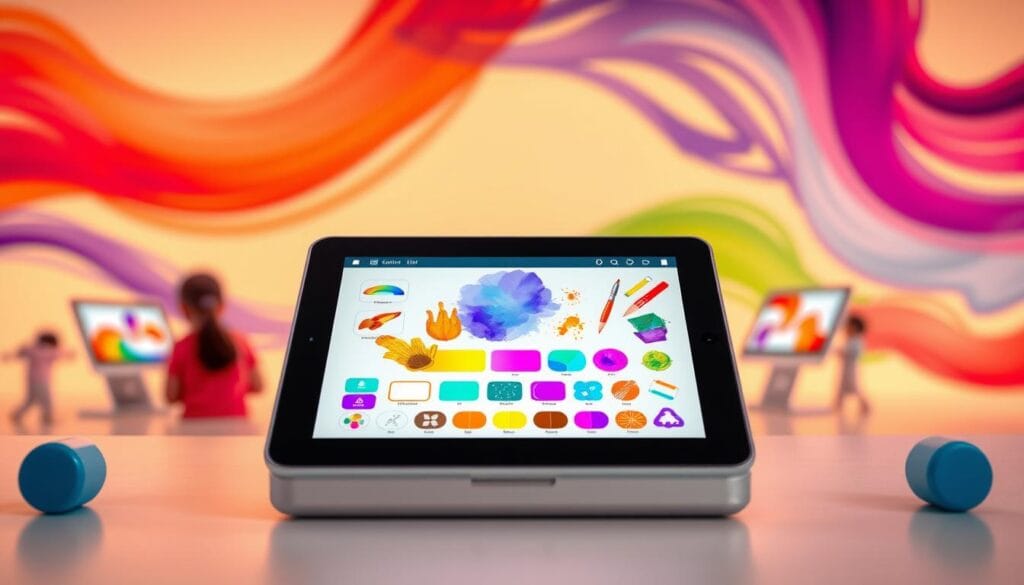
In today’s world, technology is changing how we learn colors. With 97% of kids aged 3 to 18 having internet at home, digital tools can help with color learning.
Check out these cool digital tools that make learning colors fun and interactive:
- Drawing with Carl (Ages 2-5): Teaches basic color recognition
- Coloring Book (Ages 2-8): Has 128 pages for drawing and coloring
- Joy Doodle (Ages 2-6): Uses bright neon colors
- Sketchbook (Ages 5+): Offers top-notch drawing tools
Parents should follow the American Academy of Pediatrics’ rules. They say kids aged 2-5 should watch only one hour of quality content. Choose apps that teach and let kids explore colors.
“Technology can be a powerful learning tool when used mindfully and purposefully.” – Educational Technology Expert
When picking digital color learning apps, look for these features:
- Interactive color mixing experiments
- Engaging visual interfaces
- Age-appropriate challenges
- Parental control settings
Remember, digital tools should add to, not take away from, hands-on color learning. Mix technology with real-world activities for a well-rounded color education.
Creating a Color-Rich Learning Environment at Home
Turning your home into a colorful learning space can boost your child’s creativity. Color therapy shows that well-designed areas can help with thinking and feeling better. By using smart color branding, you can make a fun place for learning that sparks your child’s imagination.
Setting up art stations is key. Choose places with lots of natural light and organize materials in a way that looks good and is easy to get to. Use color-coded labels on storage containers so kids can pick what they need by themselves. Rainbow-organized shelves can make organizing fun and educational.
Displaying art is important for keeping the space inspiring. Create a gallery wall where your child’s art is the main attraction. Use magnetic boards, clip systems, or frames that let you change things often. These displays celebrate your child’s creativity and help them learn about colors and art.
A colorful home is more than just pretty—it’s about sparking curiosity and fun learning. By using color therapy and smart design, you can turn regular spaces into places that help your child grow and be creative.
FAQ
How do colors impact my child’s emotional development?
Colors affect emotions by causing different feelings. Warm colors like red and orange make us excited. Cool colors like blue and green help us relax. Knowing color psychology helps create better learning spaces for kids.
At what age can children start learning about colors?
Children start noticing colors around 18 months to 3 years. By 4, they can name basic colors. But, learning colors is a lifelong process. Fun activities and books make it exciting.
What are the best ways to teach colors to young children?
Hands-on activities like mixing colors and art projects are great. Nature walks and interactive stories also help. Use games and digital tools too. A colorful home environment is key.
How can I use colors to enhance my child’s creativity?
Encourage creativity with art supplies and art stations. Let them mix colors freely. Use stories and nature to inspire. Celebrate their unique art.
Are digital tools effective for teaching colors?
Digital tools can be helpful but should not replace hands-on learning. Apps and games can make learning fun. But, real-world experiences are essential for learning.
How do primary colors work, and why are they important?
Primary colors (red, blue, and yellow) can’t be mixed from other colors. They’re the base for all other colors. Learning about primary colors helps kids solve problems and be creative.
Can color learning help with my child’s cognitive development?
Yes, color learning boosts thinking and problem-solving. It improves visual skills and fine motor control. It makes learning fun and engaging.
How can I create a color-rich learning environment at home?
Use color-coding for art supplies and display kids’ art. Add colorful decor and natural light. Make your home a place of creativity and learning.
